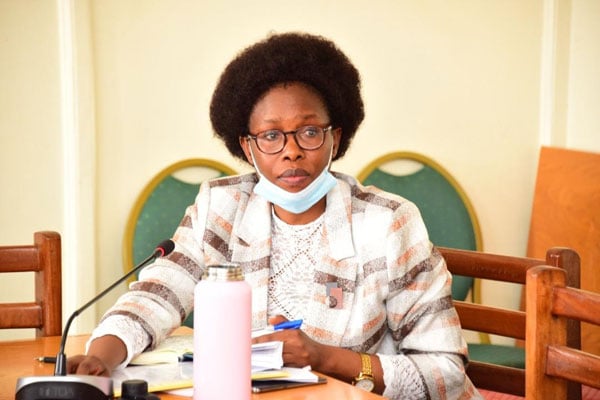Prime
Why farmers must register farmland

Farmers scout for weeds on their garden. Most farm land is communially owned. Photo/Lominda Afedraru
What you need to know:
- Some of the findings indicate that the expected contribution of the land sector to Uganda’s GDP cannot be measured directly but only through proxy indicators on revenue generated from the Land.
Uganda’s population continuously increasing means the land per square km per person is decreasing meaning intensive ways of farming must be adopted
Households with limited access to land are found to use more labour per unit area cropped, substituting more intensive and labour demanding production for extensive, land demanding production.
Although Ugandan some farmers generally do not use inputs such as fertilisers, pesticides, hybrid seeds and modern land management practices, land poor smallholder farming households have been found to use many of these inputs more intensively than farming households with larger landholdings.
As such, access to land is a key factor affecting the intensity of land management, the use of
Higher yielding agricultural technologies, the profitability of agricultural enterprises, and rural poverty.
These are some of the points discussed by stakeholders during a recently concluded meeting by ministry of land during a review of the national land policy meeting
National land policy
In 2013, the government formulated a comprehensive National Land Policy (NLP) as a framework for the efficient, equitable and optimal utilisation and management of Uganda’s land resources for poverty reduction, wealth creation and overall socioeconomic development of the country.
The NLP draws its policy principles from the Uganda Constitution of 1995 as amended and several other macro-policy development frameworks that articulate
Uganda’s medium and long-term vision to achieve socio-economic transformation over time.
The National Land Policy provides for optimal utilisation and management of land resources since most Ugandans are dependent on land for employment and survival. It consolidates the various scattered policies associated with land and natural resources with an emphasis on both land ownership and development.
It proposes reforms to strengthen the vitality of Uganda’s productive sectors for socio-economic transformation.
It is specifically formulated to reduce ambiguity at the sector level by comprehensively integrating scattered and isolated policy statements on different aspects of sustainable land use such as demands in agriculture, environment, natural resources management, housing, real estate development, transport and private sector development as well as industrialisation to address the historical complexities and fundamental issues underlying land tenure relations.
It is against this background that the ministry of lands and stakeholders were reviewing performance of the policy to take action in areas that are not working well including the agriculture sector.
Land tenure system and ownership
The Land Act of Uganda 1998 recognises four major systems of land tenure, customary tenure is the most common tenure system in Uganda whereby access to land is governed by the customs, rules, and regulations of the community.
Holders of land under the customary system do not have a formal title to the land they use, but generally have secure tenure.
The other is mailo tenure which is freehold system established by the British in 1900 to reward colonial agents who advanced their interest especially in the central region.
Freehold tenure is another system whereby owners of the land have a title to their land which allows them to hold the registered land indefinitely and the owner is given complete rights to use it
The last is the leasehold tenure which is a system where the owner of the land grants the tenant exclusive use of the land, usually for a specific period of time. The land may also be leased from the state to individuals for typical lease periods of five, 45 or 99 years.
However most farmers fall under the customary land system where they tend to lack several opportunities that could favour them to advance their agriculture initiatives.
Unregistered land challenge to the farmer
Dr Margaret A. Rugadya a private consultant who participated in review of the policy explained that it is important for farmers to register their land in a bid to access opportunities such as credit facilities from banks because it is a requirement.
In her findings in 2022, Bank of Uganda recorded an increase in cumulative loan applications with a total loan value of Shs1.05t up from Shs988b as at June 2021 under the Agricultural Credit Facility for smallholder farmers.
Despite this rise in access to credit, smallholder farmers are using non-land collateral to secure such loans, showing a high need to collateralize smallholders’ land through titling.
Sometimes, households pursue land titles not to access credit, but to address land disputes, and transgenerational transfers rather than investment.
An additional measure considered is the number of Certificates of Customary Ownership issued in northern and eastern Uganda, standing at a total of 54,545 as of March 2023.
Since there is available money in the bank to borrow to farmers, the bank has since devised a method of using farmer groups for them to access this money. Most farmers in Kasanda and Mubende are accessing this money because they have strong farmer groups.
She recommends farmers to ensure their land is registered in order to grab some of the opportunities to increase in their agricultural productivity.
The permanent secretary ministry of lands Dorcas Okalanyi noted that the land policy is crucial in the farming communities because it enables sustainable land use in other sectors.
Land as revenue earner
Some of the findings indicate that the expected contribution of the land sector to Uganda’s GDP cannot be measured directly but only through proxy indicators on revenue generated from the Land.
Information system comprising non-tax and tax revenues, collected as fees, stamp duty on land related activities and other charges to the Consolidated Fund.
Whereas revenues generated in the pilot phase of the Land integration system were promising, these have drastically declined since integration with the Uganda Revenue Authority (URA).




